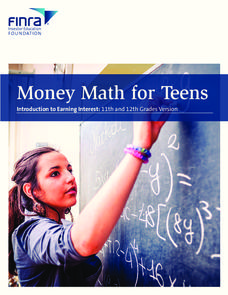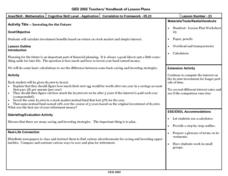Council for Economic Education
Calculating Simple Interest
How much is owed? A calculated resource introduces the simple interest formula with a video that describes how to use it. Classmates then show what they know by answering questions within a simple interest worksheet.
West Contra Costa Unified School District
Interest and the Number e
Mary, Mary, quite continuously, how does your money grow? Uses examples to examine the difference between simple interest and compound interest, and to take a look at different rates of compounding. Learners explore what would happen as...
EngageNY
Why Do Banks Pay YOU to Provide Their Services?
How does a bank make money? That is the question at the based of a activity that explores the methods banks use to calculate interest. Groups compare the linear simple interest pattern with the exponential compound interest pattern.
SaveandInvest.org
Introduction to Earning Interest: Middle School
Does your bank pay you for allowing them to hold your money? Class members research three different ways they can earn money using money already in the bank. Topics include certificates of deposit, statement savings accounts, and money...
SaveandInvest.org
Introduction to Earning Interest: Grades 11-12
Does your bank pay you for allowing them to hold your money? Class members investigate three different ways money can make more money. Topics include certificates of deposit, statement savings accounts, and money market accounts. This...
SaveandInvest.org
Introduction to Earning Interest: Grades 9-10
Does your bank pay you for allowing them to hold your money? The lesson covers three different ways your money can make money. Topics include certificates of deposit, statement savings accounts, and money market accounts.
Curated OER
The Business of Interest
Students explore the concept of simple and compound interest. For this interest lesson, students discuss how interest works on a loan. Students calculate simple and compound interest on loans of fictitious characters from a video.
Curated OER
M&M Interesting
Students examine the concepts of trade-offs and opportunity cost to decide between savings accounts with simple interest and those with compound interest. They calculate interest earned on account balances while working in groups and...
Curated OER
Investing for the Future
Twelfth graders perform basic calculations for saving and investment strategies. they simulate the investment of $1,000 in the stock market and savings account. they determine which pays the greater dividend.
Curated OER
Interesting Interest Rates
Your young bankers compare earning interest accumulated yearly and monthly to decide which method most increases their balance. Using an exponential function to model the bank balance affords the learners more practice connecting these...
Curated OER
Introduction to Earning Interest: What are APR and APY?
Learners explore saving and investing money. In this middle school personal finance lesson, students define and use investment vocabulary, explore compound interest and its effect of savings, and compute simple and compound interest. ...
Curated OER
Compound Interest
For this consumer math worksheet, students read an example of how to use the interest formula to compute interest that is compounded daily over six years. They complete a chart where they compute the interest earned over 10 years when...
Curated OER
Calculating Interest
Students explore the concept that when money is borrowed, people pay to use it because someone else is losing an opportunity to use it while they have it. What you pay to use the money is called interest. The rate of interest is a...
Curated OER
Data Analysis: Investing is an "Interesting" Experience
Students compute interest earned. For this data analysis lesson, students examine investments and interest rates. They compute the total interest earned and find the simple interest.
Curated OER
Solving Problems Using Interest
In this math worksheet, young scholars look for the solutions to the problems using interest. Then they calculate the new principal after adding the interest.
Curated OER
Time Value of Money- Compound Interest
Pupils study the concept of compound interest as it relates to the time value of money.
Curated OER
How Do You Double Your Money?
Students understand how to calculate the return on investments for various rates and lengths. Also, they compare their results with the StocksQuest Calculator, which lists calculations year by year.
Visa
A Way to Wealth: Understanding Interest and Investments
Money motivates! Help young bankers understand how math plays a part in investing. Give learners math practice while instilling real-world financial literacy skills.
Curated OER
Calculating A Car Payment
Students choose a car from an Internet used car dealer and then calculate their monthly payment. All the necessary resources and formulas are provided. This is a simple, but practical and effective, lesson for a math or life skills class.
EngageNY
Credit Cards
Teach adolescents to use credit responsibly. The 32nd installment of a 35-part module covers how to calculate credit card payments using a geometric series. It teaches terminology and concepts necessary to understand credit card debt.
02 x 02 Worksheets
Inverse Variation
Discover an inverse variation pattern. A simple lesson plan design allows learners to explore a nonlinear pattern. Scholars analyze a distance, speed, and time relationship through tables and graphs. Eventually, they write an equation to...
Curated OER
Credit Purchases
Twelfth graders calculate interest on purchases bought with a credit card. They use the formula I=PRT to find the interest. In pairs, they use a flyer to calculate the interest for electronic items.
Curated OER
Spend, Save, Invest or Donate (9-12)
High schoolers explore the concept of personal finance. In this philanthropy lesson, students examine decisions they make about money as they discover the definitions of philanthropy, resources, scarcity, choice, benefits, costs,...
Curated OER
Thinking About Credit
Learners explore the concept of credit. In this credit lesson, students discuss what it means to buy items using credit. Learners discuss how interest accrues and how much is really being paid with a credit card. Students calculate...

























